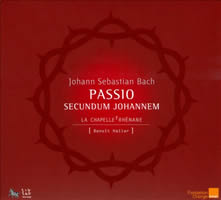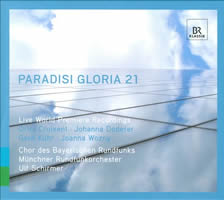Nine Plus
|
Dan Albertson [April 2011.] [The Bruckner obsession is now tempered only slightly. Thank you, Thành Lu, for the tacit agony and so much more heretofore. Thank you, Sid Samberg, for not being offended when an earlier attempt at humor was theoretically misconstrued in this very space: I make fun only of myself in these columns, and indeed in life, no one else. D.A.]
Anton BRUCKNER: Symphony No. 9 in D minor (1887-96) (Nowak ed.). Minnesota Orchestra, Stanisław Skrowaczewski (cond.). Reference Recordings RR-81CD (http://www.referencerecordings.com/). Recorded in Minneapolis, 11/1996. The performance is idiosyncratic, as is the CD presentation, with I (22:55) subdivided into seven indices, II (10:16) into three and III (26:20) into seven. In the opener, the brass is sometimes ungainly, from nowhere. The reprise of the first climax, represented by index 4, is surely more frenetic than necessary, almost insane. S.S. brings a pointed approach to the rhythms of the scherzo, not alien to the music, yet aloof from my taste. His flute and oboe soli in the trio are lovely, the trumpets in the scherzo proper sometimes almost spotlit. The finale plods, yet at least the balances are good. Middling.
Johann Sebastian BACH: Passio secundum Johannem (hybrid of versions from 1724 & 1725). Julien Prégardien (T: Evangelist), Benoît Arnould (bar & Jesus), Dominik Wörner (bar & Peter & Pilate), Tanya Aspelmeier & Salomé Haller (S), Julien Freymuth & Pascal Bertin (ct), Michael Feyfar & Philippe Froeliger (T), La Chapelle Rhénane, Benoît Haller (dir.). Zig-Zag Territoires ZZT 100301.2 (http://www.outhere-music.com/en/labels/zig-zag-territoires). Distributed in the US by Allegro Music (http://www.allegro-music.com/). One-per-part, almost. Prima parte 39:47, seconda parte 76:08. Mostly 1725 here, so no Ach, Betrachte or Erwäge, but three superb replacements, given fervent readings; Haller et al. could not, however, resist the opening chorus, which is statelier than usual of late. Its restrained ornamentation and trenchant, low strings soon cloy, foreshadowing a straight, almost passionless passion. Dry arie, with fine, if not distinctive singing, coupled with very dramatic recitativi. Prégardien Sohn a promising follower to Prégardien Vater, but not yet comparable. An unexpected pause of 0:18 in the final track prefaces the closing chorale, Christe, du Lamm Gottes, making it seem an afterthought. Pierlot and crew have a new passion, too, which I suspect will be worthier. If one must have the 1725 version, without the 1724 chorus at the start, try Herreweghe II. Why has no one tried the ultimate hybrid, i.e. the complete passion music, from which listeners could build their own versions? A track listing with timings would have been splendid, and would seem a curious omission, but otherwise, the notes are useful.
“Paradisi Gloria 21.” Oriol CRUIXENT: Abismes (2007). Gerd KÜHR: Introductio – Meditatio – Magnificat – Epilogus* (2007-08). Joanna WOŹNY: Archipel (2008). Johanna DODERER: Salve Regina** (2008-09). Angelika Luz* (high S), Marlis Petersen** (S), Adrian Eröd* (bar), Chor des Bayerischen Rundfunks (Kaspars Putniņš, dir.)* & (Florian Helgath, dir.)**, Münchener Rundfunkorchester, Ulf Schirmer (cond.). BR-KLASSIK 900302 (http://www.br-klassik.de/). Distributed in the US by Naxos (http://www.naxos.com/). Four premières here on religious subjects, recorded live in 2008 and 2009. Cruixent, heretofore unknown, calls his work a “diptyque,” which it is. The first part becomes preoccupied with gestures intended as stirring, yet veering toward MacMillanesque kitsch. When some musicians chant words from the Gospel of Matthew and the music that follows is a pastoral cliché for winds, with what one hopes is an unintentional resemblance to Funiculì funiculà, any hope of credibility is lost. Tibetan bowls to close only seal the fate. Thank you, Sir John Tavener. Kühr, much older, brings more acumen. Rather than a straightforward setting of the Magnificat, he provides context, and despair, via Rilke and Lichtenberg. The soprano has a tessitura usually so high as to make comprehension an illusion. For once, I complain not. The orchestration is mostly reduced, often inaudible, some choral and percussive indulgences forgiven, and the skeptical approach is a sage one in this case: music and text as fragile beings, not reassuring ones. Woźny proves that a sound, ravishing for a few minutes, will aggravate after 18. Her quiet take on Eastern-European minimalism inhabits a world of extreme dynamic registers, here without any development or relent. If Woźny lingers in the mire, Doderer errs on the side of the jovial. Her setting is direct and devout, colorful and variegated, yet lacking a unified vision. Chipper instead of exalted, perhaps. The organ, when deployed, is a presence much welcomed. Pergolesi need not fear being usurped. Presentation is good, replete with texts.
[More Dan Albertson]
[More
Bruckner]
[Previous Article:
Mostly Symphonies 17.]
[Next Article:
Rameau, présent et absent]
|


